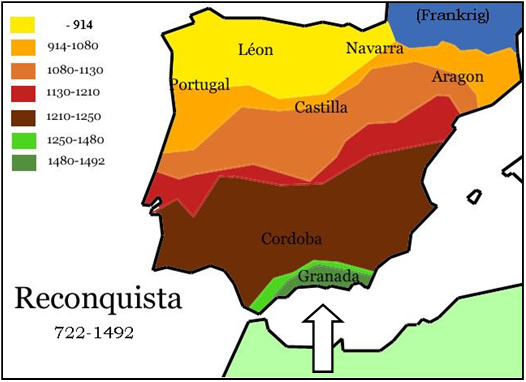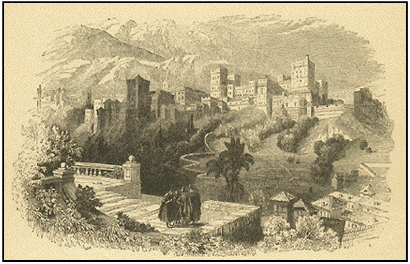


SPAIN -
xxxxxAs  we have seen, the beginning of the end of Muslim power in Spain came in 1212 (JO) with the battle of Las Navas de Tolosa. It was then that a large Christian force led by Alfonso VIII, king of Castile, defeated the army of the Almohads. Within twenty years the Almohad empire was on its last legs, and virtually came to an end when Ferdinand III of Castile and Leon captured Seville in 1248.
we have seen, the beginning of the end of Muslim power in Spain came in 1212 (JO) with the battle of Las Navas de Tolosa. It was then that a large Christian force led by Alfonso VIII, king of Castile, defeated the army of the Almohads. Within twenty years the Almohad empire was on its last legs, and virtually came to an end when Ferdinand III of Castile and Leon captured Seville in 1248.
xxxxxBut the final overthrow of the Muslim invaders was to be a long time in coming. It was not until 1469 (E4), with the marriage of Ferdinand of Aragon and Isabella of Castile, that the joint union of these two major kingdoms set the stage for the making of Spain as a national state. By that date the only Muslim area remaining in Spain was situated in the south-
xxxxxThe  beginning of its end came in 1481, however, when the Spanish monarchs, Ferdinand and Isabella, resumed their “crusade”, determined to rid their country of the one remaining area of Moorish rule. After a costly campaign which lasted more than ten years, the Moorish kingdom was slowly reoccupied. With help from all over Europe and a formidable use of artillery, the Moorish strongholds -
beginning of its end came in 1481, however, when the Spanish monarchs, Ferdinand and Isabella, resumed their “crusade”, determined to rid their country of the one remaining area of Moorish rule. After a costly campaign which lasted more than ten years, the Moorish kingdom was slowly reoccupied. With help from all over Europe and a formidable use of artillery, the Moorish strongholds -
xxxxxIncidentally, the first monarchs of a united Spain, Ferdinand and Isabella, are buried in the city's cathedral.
xxxxxAs we have seen, the beginning of the end of Muslim power in Spain came in 1212 (JO) with the Christian victory at the Battle of Las Navas de Tolosa. With the capture of Seville in 1248, only an area, centred on Granada, remained in Muslim hands. Over the next century and a half this tiny kingdom remained at peace, and flourished as an important centre of trade and learning. However, with the marriage of Ferdinand of Aragon and Isabella of Castile in 1469 (E4), the stage was set for the making of a Spanish national state. They launched a “crusade” against this Moorish enclave and, during a war lasting more than ten years, the major strongholds were slowly forced to surrender, and the city of Granada itself was finally taken in 1492. In 1501 Granada was declared a Christian kingdom, and Muslims were given the choice of conversion or expulsion.



Acknowledgements
Map (Spain): licensed under Creative Commons. Translated by Sten – commons.wikimedia.org. Granada: contained in Orbis Pictus (The Visible World in Pictures), published by the German author Otto Spamer (1820-
H7-